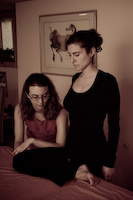Rolfing® Structural Integration and Yoga
Rolfing and yoga are complementary. I encourage everyone to have a body-aware conscious movement practice, such as dance, tai chi, walking, or even running if performed with awareness. But of all movement disciplines, yoga is one of the best for maximizing the results from Rolfing.Ida Rolf practiced yoga, and it influenced many of her ideas about correct movement and alignment.
When you combine Rolfing and yoga, you get synergistic effects beyond the benefits of either alone. As Rolfing opens up new possibilities for movement, yoga provides a way to explore and enhance the new movement patterns. While you are in this stage of relearning how to move, it is essential to slow your practice down. As you transition between poses slowly, you can tune into the details of your movement—where you feel the effort, if it is equal on each side of the body, and so forth. Part of slowing down is holding each pose a little longer, so you have time to play with your body usage in the pose. How are you supporting through the legs and hips? Where is center? How far into the pose is your limit, where you can still keep the integrity of the pose? Often, backing off slightly allows for a better pose.
"My experience with Karin and the 10-Series was life-changing. The work has transformed my yoga practice, and my perspective is richer and broader. Karin brings a wonderful combination of intuition and intelligence to her work."
- Patricia Nardone, RN, Ph.D.
A 10-session series of Rolfing can dramatically propel your yoga practice. During the series you will achieve advancements in your practice that might take five years to accomplish through yoga alone. Plus, with improved body usage and awareness, you can avoid yoga-related injuries.
Your yoga practice can serve as a touchstone for monitoring your process in the Rolfing series. You will feel some poses get easier, or simply more joyful. You may also become aware of some poses that are still difficult, or that you dislike. In the last three sessions of the series, we can work directly with these poses. First, I will watch you do the pose and observe what may need to change. The pose highlights places in your body that still need work. Perhaps there could be better support in your left foot in standing poses, or there may be a line of strain through your pelvis when you do pigeon pose on the right side. Maybe twisting is easier on one side. Or perhaps you realize that you find backbends to be fun, while forward bending feels like a struggle. We will find a way to do hands-on work while you are in the pose, or a modified version of the pose that allows you to be comfortable while I work. In this way, we use your yoga practice to help us address any remaining issues in the body.


